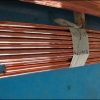
Brass is a copper alloy with zinc as the main additive element. It has a beautiful yellow color and is collectively called brass. Copper-zinc binary alloy is called ordinary brass or simple brass. Brass with more than three type is called special brass or complex brass. Brass alloys with a zinc content of less than 36% are composed of solid solution and have good cold working properties. For example, brass with a zinc content of 30% is commonly used to make bullet cases, commonly known as bullet case brass or seven-three brass. Brass alloys with a zinc content between 36% and 42% are composed of solid solutions, and the most commonly used is six-four brass with 40% zinc. In order to improve the performance of ordinary brass, other elements such as aluminum, nickel, manganese, tin, silicon, lead, etc. are often added. Aluminum can increase the strength, hardness and corrosion resistance of brass, but reduce its plasticity. It is suitable for marine condensers and other corrosion-resistant parts. Tin can improve the strength of brass and its corrosion resistance to seawater, so it is called naval brass and is used for ship thermal equipment and propellers. Lead can improve the cutting performance of brass; this kind of free-cutting brass is often used as watch parts. Brass castings are often used to make valves and pipe fittings.
Bronze originally refers to copper-tin alloy, and later copper alloys other than brass and cupronickel are called bronze, and the name of the bronze is often named as the first major additive element. Tin bronze has good casting performance, anti-friction performance and good mechanical performance, and is suitable for manufacturing bearings, worm gears, etc. Lead bronze is a bearing material widely used in modern engines and grinders. Aluminum bronze has high strength, good wear resistance and corrosion resistance, and is used to cast high-load gears, bushings, and marine propellers. Beryllium bronze and phosphor bronze have high elastic limit and good conductivity, and are suitable for manufacturing precision springs and electrical contact components. Beryllium bronze is also used to make non-sparking tools used in coal mines and oil depots.
Cupronickel is a copper alloy with nickel as the main additive element. The copper-nickel binary alloy is called ordinary cupronickel; the cupronickel alloy with elements such as manganese, iron, zinc, and aluminum is called complex cupronickel. Industrial copper-nickel alloy is divided into two categories: structural copper-nickel alloy and electrical copper-nickel alloy. Structural white copper is characterized by good mechanical properties and corrosion resistance, and beautiful color. This kind of cupronickel is widely used in the manufacture of precision machinery, chemical machinery and ship components. Electrician White
Copper generally has good thermoelectric properties. Manganese copper, constantan and test copper are manganese cupronickel with different manganese content. They are materials used to manufacture precision electrical instruments, varistors, precision resistors, strain gauges, thermocouples, etc.
The copper is named for its purple-red color. It is not necessarily pure copper, sometimes a small amount of deoxidizing elements or other elements are added to improve the material and performance, so it is also classified as a copper alloy. China’s copper machining materials can be divided into: ordinary copper (T1, T2, T3, T4), oxygen-free copper (TU1, TU2 and high-purity, vacuum oxygen-free copper), deoxidized copper (TUPTUMn), and added a small amount of alloying elements There are four types of special copper (arsenic copper, tellurium copper, silver copper). The electrical conductivity and thermal conductivity of copper is second only to silver, and it is widely used in the production of electrical and thermal equipment. Red copper has good corrosion resistance in the atmosphere, sea water, certain non-oxidizing acids (hydrochloric acid, dilute sulfuric acid), alkali, salt solution and a variety of organic acids (acetic acid, citric acid), and is used in the chemical industry. In addition, red copper has good weldability and can be processed into various semi-finished and finished products through cold and thermoplastic processing. In the 1970s, the output of red copper exceeded the total output of other types of copper alloys.






